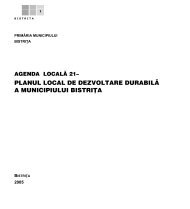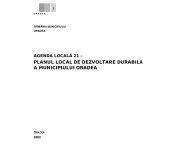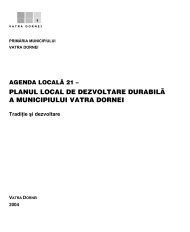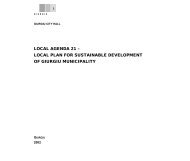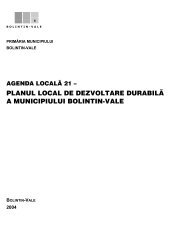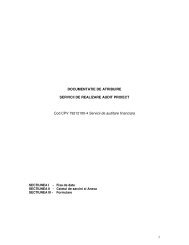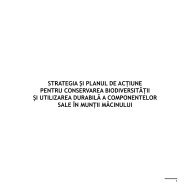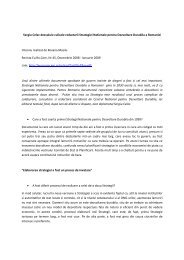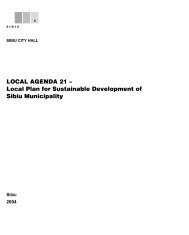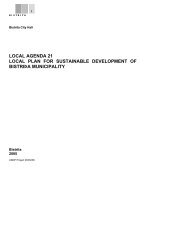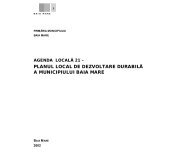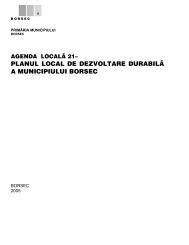English Version - United Nations Development Programme Romania
English Version - United Nations Development Programme Romania
English Version - United Nations Development Programme Romania
You also want an ePaper? Increase the reach of your titles
YUMPU automatically turns print PDFs into web optimized ePapers that Google loves.
a constant decline. Thus, in 1998, 62.4 billion tons /km were transported. Out of these 62.4 billion tons<br />
km, 19.7 billion tons /km were transported by train, and 15.8 billion tons /km were transported on roads.<br />
In the same year, 24.2 billion passengers /km were transported, 13.4 billion passengers km by train and 9<br />
billion passengers km on roads.<br />
Moreover, the transition to a market economy profoundly changed the way in which specialised<br />
transportation units are organised and the way in which property is organised. Specifically, the transition<br />
process led to an increase in the number of privately owned businesses and joint ownership. Currently,<br />
the transportation sector and related sectors have 12,250 active authorised and licensed economic agents<br />
who represent 6% of the total wage earners in the economy.<br />
In the context of the existing legislative framework, private businesses and economic agents can<br />
act freely and independently, since the Department of Transport, as a governmental authority, no longer<br />
acts as a manager and administrator, but rather as a regulating, authorising, and licensing body.<br />
Access to the transportation infrastructure is free and equal for all transport operators. The<br />
maintenance of the infrastructure is predominantly provided by the national companies resulted from the<br />
reorganised units of the state transport sector.<br />
The main goal of the transport policy is the restructuring of the national transport system and its<br />
proper functioning, with a view to create of a homogeneous transport system, connected, from an<br />
infrastructural point of view, to the pan-European road network, which should also connect more isolated<br />
areas. This restructuring process should consider offering high-quality domestic and international<br />
transportation services.<br />
Ensuring the financing, from domestic and external resources, of major projects that seek to<br />
modernise the transportation infrastructure is a priority matter, since the modernisation of the<br />
transportation infrastructure would stimulate the development of other sectors of the economy. This<br />
would also reduce unemployment, since every employee in the transportation sector leads to the creation<br />
of 5 jobs in sectors related to transportation (maintenance, constructions, services).<br />
Central and local administrations, as well as economic agents, should get involved in finding the<br />
financial resources needed to make sure that the impact of traffic on the environment is reduced (this<br />
includes the rigorous limiting of the level of polluting emissions and the in-traffic controlling of these<br />
emissions).<br />
The guiding principles in the policies leading to the sustainable development of the transportation<br />
sector are:<br />
On the domestic market, regulations are meant to bring the level of pollution to E.U.'s standards.<br />
This includes: fiscal and legislative co-ordination, competition, equal access, market liberalisation,<br />
rehabilitation and modernisation of infrastructure and equipment, ensuring communications and cooperation<br />
between different means of transport, improving the quality of transportation services and<br />
of the related sectors, development of a managerial culture capable of leading transport companies<br />
and joint-stock companies, internalising external costs, guaranteeing communitarian rights (goods --<br />
motor vehicles, services, persons -- the right to settle), signing of the transport agreement with the<br />
E.U., which is being negotiated, as well as the E.U. agreement regarding the incidental transportation<br />
of passengers, the agreement between <strong>Romania</strong> and the E.U. regarding the road transit of goods, the<br />
Agreement between the CE and its associates (including <strong>Romania</strong>), Norway, and Iceland regarding<br />
the creation of a collective flight zone.<br />
Creation of a pan-European transport network and its connection to the TRACECA corridor<br />
(Transport Corridor Europe-Caucasus-Asia). In order to accomplish this, it will be necessary to<br />
concentrate financial resources (from the state budget and from external sources) on the<br />
modernisation and development of a transport infrastructure, and, in order to achieve this, to attract<br />
non-refundable financing from the PHARE Program. There are already funds designated to the<br />
development and improvement of transportation infrastructure (the special fund for public roads and<br />
the special fund for airlines). Regarding the connection to TRACECA, the pan-European corridor<br />
number VII, with the Danube possibly playing an important role (connecting Western Europe and the<br />
Black Sea through the Danube-Black Sea Canal), since water transportation is cheap and has a low<br />
level of polluting potential.<br />
Guaranteeing traffic safety and safety of goods and passengers . It will be necessary to comply<br />
with technical standards, to modernise the infrastructure, means of transport, and equipment, to grant<br />
technical licences for vehicles, to regulate the transportation of dangerous goods, to implement and<br />
apply the Control System regarding the compliance of ships (PSC and fire prevention) with<br />
international provisions.<br />
Environmental protection and conservation. A sustainable transport policy must be achieved by<br />
using ecological types and means of transportation. It will be necessary to appeal to de-polluting<br />
technologies and preventive measures in order to diminish the effects of pollution (for example,<br />
50



